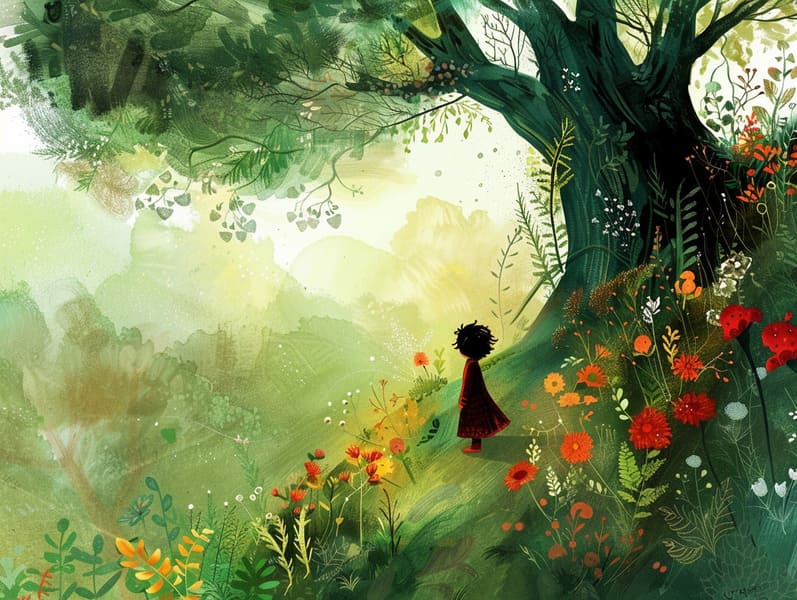
Children's fairy tales have timeless appeal. These stories have been recounted from one generation to the next far before they were ever transcribed. They were born from a variety of traditions, including Indigenous traditions. They were initially narrated among adults, often carrying themes and messages concerning the societal norms and beliefs of the time.
The renowned Brothers Grimm, Jacob and Wilhelm Grimm, were among the first to gather many of these beloved fairy tales. Their compilation, "Grimm's Fairy Stories," included stories like "The Little Glass Slipper," "The Story of Hansel and Gretel," and "Snow White," which have since become mainstays in the world of children's fairy tales. Similarly, Hans Andersen's fantastical stories, such as "The Mermaid's Tale," and "The Little Duckling," have touched hearts worldwide, securing their place in the pantheon of timeless fairy tales.
Though they are old, these stories remain as important as ever, especially as bedtime stories for kids. These delightful tales are now available in multiple formats, including vibrantly illustrated books, enchanting animations, and web-based fairy tales.
Their lasting appeal can be ascribed to several whimsical characteristics:
Vital Lessons: Classic fairy tales often teach important moral lessons. Fairy tales like "The Boy Who Cried Wolf" teach the significance of truthfulness, while "The Tale of the Tortoise and the Hare" exemplify the traits of perseverance and modesty. These narratives offer the young clear distinctions between ethical and unethical, helping to shape their moral compass in a mild yet meaningful way.
Compassion and Knowledge: Ancient fairy tales frequently include heroes facing tests and troubles, provoking young readers to feel with their struggles and applaud their triumphs. For instance, "The Story of Beauty and the Beast" highlights the importance of seeing beyond the surface to acknowledge the real character of a person, advancing tenderness and discernment.
Cultural Awareness: Many traditional fairy tales are interwoven with the cultural contexts from which they grew. Discovering these stories can provide intriguing perspectives into different historical contexts, encouraging a sense of global understanding and awareness.
Inventiveness and Fantasy: The supernatural elements in classic fairy tales—magical spells—boost children’s fantasy worlds. These stories bring readers to supernatural realms, motivating creative dreams and a sense of awe that continues a lifetime.
Ancient fairy tales are not only delightful but also pedagogical. They function as delightful tools in building various thinking and feeling skills in children. When fairy tales are told out loud, they advance verbal development by bringing new linguistic elements and sophisticated sentence structures. This practice also promotes auditory perception and mental focus, as kids follow the story, enthusiastic to see what happens next.
Furthermore, analyzing the themes and characters of ancient fairy tales can strengthen cognitive skills and reasoning skills. Kids are guided to notice patterns, anticipate outcomes, and make sense of cause and effect. These explorations also encourage the young voice their thoughts and feelings, strengthening their emotional intelligence.
In today’s information age, the accessibility of web-based fairy tales has made these tales more within reach than ever. Web-based platforms and apps give vast collections of traditional fairy tales that can be viewed or listened to anytime, anywhere. Fairy tales recited are particularly in demand, extending an fascinating method for young readers to delight in these magical stories. Sound books and spoken videos transport characters and settings to life, often accompanied by entrancing melodies and music that heighten the narrative journey.
The timeless fascination of ancient fairy tales lies in their ability to adjust to present eras while keeping their core values. Contemporary modernizations of these narratives often introduce more different protagonists and modern settings, making them pertinent to today’s audience. However, the main ideas of heroism, benevolence, and lawfulness remain unchanged, continuing to move listeners of all ages.
Fairy tales also offer a sense of familiarity and understanding. They impart upon a well-arranged narrative with a straightforward beginning, middle, and end, often drawing to a close with the finalization of conflicts and the triumph of rightness over wrongness. This regularity can be reassuring for young ones, extending a sense of reliability in an dynamic world.
Old fairy tales continue to charm and inform new generations, maintaining their beauty and value in modern society. As children's night stories, they put out a perfect blend of charm and enlightenment, furthering moral values, empathy, and creativity. The availability of free fairy tales online and the commonness of fairy tales read aloud certify that these classic tales remain accessible to new generations.
By defending and relating these fairy tales, we continue to acknowledge the rich tapestry find it here of fables and cultural heritage. Whether you are discovering a richly illustrated book, delving into a electronic library, or listening through an voice book, the magic of famous fairy tales is always within reach. These stories illustrate of the persistent force of stories and its ability to tie us across generations and cultures.
Be it you are discovering a colorful picture book, enjoying a digital library, or listening to an audio story, the grandeur of timeless fairy tales is always within reach.
These tales illustrate of the invariable nature of storytelling and its ability to bind us across eras and regions, establishing a link that charms and informs alike.